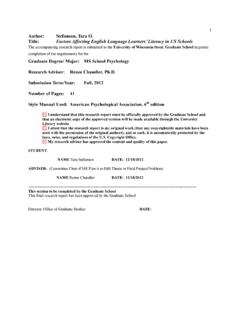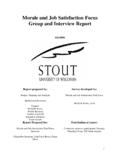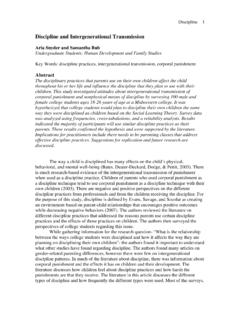Transcription of Training Needs Assessment for Warehouse …
1 Training Needs Assessment for Warehouse Employees By Michelle Beckman A Research Paper Submitted in partial Fulfillment ofthe Requirements for the Master ofScience Degree In Training and Development Approved for Completion of4 Semester Credits TRHRD-7 Dr. Katherine Lui The Graduate School University of Wisconsin-Stout May, 2007 1 The Graduate School University of Wisconsin-Stout Menomonie, WI Author: Beckman-Kern, Michelle L. Title: Training Need Assessment for Warehouse Employees Graduate Degree/ Major: MS Training and Development Research Adviser: Dr. Katherine Lui MonthNear: May 2007 Number of Pages: 33 Style Manual Used: American Psychological Association, 5th edition ABSTRACT Warehousing has been traced back to the 1700's and it coincides with the westward expansion (Pomeranz, 1996).
2 Over the years warehousing has seen many changes. With a goal for companies to reduce slack and to stream line inventory by moving to more modem practices such as just-in-time inventories it looked like warehousing was going to be superseded. "The goal to streamline inventory is still intact, but warehousing has not only survived, it has picked up steam as a strategic logistics tool" (Saxena, 2005, p28). Many things have allowed warehouses pick up business. One of those things has been the result of manufacturing moving to Asian markets. Another reason has been their ability to justify their existence by finding better ways to meet the Needs of their customers.
3 In order to ensure better customer service warehouses have worked on their efficiency and accuracy. There are many ways to become more efficient; such as, order picking, operator Training , and Warehouse layout just to name a few. The purpose of this study is to perform a Needs Assessment to determine if Training 11 deficiencies exist and if so what objectives should be covered in order to develop the competencies that the Warehouse employees need. 111 TABLE OF CONTENTS ..Page ABSTRACT .ii List ofTables vi Chapter I: Introduction 1 Statement ofthe Problem 2 Research Objectives 3 Purpose ofthe Study 3 Assumptions ofthe Study 4 Definition ofTerms 4 Methodology "4 Chapter II: Literature Review 6 Chapter III: Methodology 14 Subject Selection and Description 17 Instrumentation 17 Data Collection Procedures '" '" 17 Data Analysis " 18 Limitations 18 Summary 18 Chapter IV: Results 19 Item Analysis 19 Chapter V: Discussion 26 Limitations , 26 Conclusions 26 iv Recommendations 27 References 29 Appendix A.
4 Needs Assessment survey 31 v List ofTables Table Years Employed at Warehouse Facility 19 Table Educational Background .20 Table Length ofTime at Current Position .20 Table Received Job Specific Training 20 Table Last Time Received Job Specific Training 21 Table Sources of Training Currently Used 21 Table Have an Individual Deployment Plan 22 Table I Received Performance Feedback 22 Table How often 22 Table Forms of Communication Used 23 Table Preferred Leaming Style/Method of Training '" 23 Table Factors that Influence Participation in Training 23 Table Will Current Company Environment Support Training 24 Table Your Ability to Identify Correct Kit Cart for Operation Being Kitted 24 Table Your Ability to Identify the Correct Plastic Bin for
5 The Operation Being Kitted , 24 Table Your Ability to Identify the Correct Process for Acknowledging that a Kit Cart is Completed '" '" 25 Table Your Ability to Identify the Correct Location to Place Kit Carts after they have been Completed 25 vi Chapter I: Introduction An important issue effecting warehouses today is competition in the marketplace. With all of the choices that consumers have the marketplace has become very competitive. In an effort to contend with their competition warehouses have had to make many changes in order satisfy their customer's Needs . Some changes include updating processes, technology and Warehouse procedures.
6 Ray Gillen, author of the article Distribution Centers Leap Ahead with Upscale Training stated that "Warehousing and distribution centers have been transformed in recent years by an explosion of technology, changing how business is conducted"(Gillen, 2001, p62). Training is important and the need for Training is growing as a result of more modem technologies being used and the need for skilled workers in the warehousing industry rising. Warehouses most commonly use Training to implement Warehouse management systems and to cross train employees on several tasks rather than to a discreete task. Warehouses may also use Training for mobile equipment operation such as fork trucks.
7 Training has long been an issue for companies even more so for smaller facilities mostly because of the cost and the times associated with Training . Smaller employee operated companies can not afford the lost time from production and do not have the number of employees required for people to be Training during working hours without loosing production (Carnevale, 1990). A Training Needs Assessment will help to make sure that time and money are not wasted on inefficient Training and it will provide the Training department a proposal showing the need for Training (Nowack, 1991). With small Training budgets and the need for skilled employees it is important that the Training be focused and appropriate.
8 A Training Needs Assessment will be able to identify ifthere is a need for Training and what Training objectives should be covered. The Warehouse facility that is currently being researched is small, there are only 14 employees. The Warehouse is located in south central Wisconsin and is a small part of a large warehousing company that is a third party logistics provider. The company's headquarters is located in the Midwest and they deal mainly in automotive logistics, some of their clients include General Motors, Subaru Indiana Automotive Inc., and DMAX LLC. The company was established in 1996 and is steadily growing with the intention of positioning themselves as the leading automotive logistics solution provider in the industry.
9 Of the warehouses 14 employees at the facility twelve are operators, one is a supervisor and one a Warehouse manager. Statement ofthe Problem The research problem will determine iftraining deficiencies do exist. Iftraining deficiencies exist the common Training Needs will be identified. The manager of the Warehouse decided that in order to become more competitive they need to make some changes. The Warehouse has identified some performance problems based on the results of some daily audits; the root cause had not been identified. The most significant performance problem is kit carts received at the production facility do not contain the correct stock and amount of stock.
10 The manager ofthe Warehouse said that audits done during the month of August showed that the average number of kit carts a week with errors was 29 carts (personal communications, February, 2007). Kit carts are assigned to a specific assembly job related to the production of the vehicle. The carts are organized with a specific number of parts that will be used to build a certain number of vehicles 2 with a specific build criteria based on each vehicles build options. When a kit cart does not contain the correct stock or the correct amount of stock a parts request form is filled out and faxed to the Warehouse .













